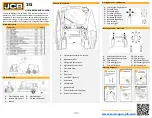
Boring a Hole
Digging the Trenches
Before drilling under a walk or driveway, you must
make an entrance and an exit trench on either side of
the drilling area. Both trenches must be at least 6 inches
wide and 18 inches deep. The entrance trench must
be at least 7 feet long and the exit trench 3 to 6 feet
long. The entrance trench should be perpendicular to
the walk or driveway 5 and the exit trench should be
parallel to the walk or driveway. The exit trench should
be centered across from the entrance trench (Figure 3).
Figure 3
1.
Entrance trench
3.
Exit trench
2.
Sidewalk
Boring the Hole
Important:
Boring is a two person operation. Do
not attempt to perform this operation by yourself.
1. Position the traction unit with the drive head at
the beginning of the trench and lower it to the
appropriate depth.
2. Stop the engine and wait for all moving parts to
stop.
3. Connect a rod and boring bit onto the drive head.
4. Connect the rod guide tool to the rod just behind
the boring bit (Figure 4).
Figure 4
1.
Sidewalk or driveway
4.
Rod
2.
Entrance trench
5.
Rod guide tool
3.
Boring bit
5. With the person guiding the boring bit positioned
to the right of the trench (Figure 4), start the engine,
move the pump selector valve to slow (turtle) (200
and 300 series traction units only), position the
throttle to within the middle of the RPM range, and
pull the auxiliary hydraulics lever rearward to start
the forward rotation of the boring bit.
6. Slowly move the traction unit forward, while the
person with the rod guide tool guides the boring bit
into the soil (Figure 4).
7. Once the entire drill bit is in the soil, push the
auxiliary hydraulics lever into neutral.
8. Stop the engine and wait for all moving parts to
stop.
9. Check the grade of the rod.
If the rod is not within the grade tolerances for the
job being performed, start the engine and drive
backward to pull the boring bit out of the soil, then
repeat steps 5 through 9, making adjustments to
correct the grade.
10. Remove the rod guide tool.
11. Start the engine and pull the auxiliary hydraulics
lever rearward to start the boring bit.
12. Slowly move the traction unit forward as the boring
bit digs into the soil.
Important:
Do not drive too fast, forcing the
bit into the soil. Allow the bit to progress at its
own rate. Never push or pull the bit through
the soil when the drive head is not turning.
13. When about 6 inches (15 cm) of rod are left showing
in the entrance trench or when the boring bit
completely enters and bores into the far side of the
6
Содержание Sitework Systems 22420
Страница 10: ...Notes 10...
Страница 11: ...Notes 11...





















